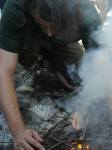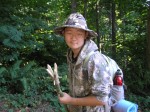
This article is being published in honor of the 2014 Great Backyard Bird Count. Check out its great video instructions and online submissions tool.
Nature’s Internet
Of all animals, birds in particular are in constant communication with one another. We can take advantage of their vocalizations to find not only them, but also to find the animals they call out. This activity is not an exact science, since one kind of bird call can sometimes have multiple meanings, but it doesn’t matter. So what if half of the times you follow a bird call, you can’t find what their fuss was about? Maybe half of the time you will!
To be clear, birds don’t sing randomly. Like all wild animals, they do everything with purpose, because wasting energy can bring death. So each bird has a range of voices and calls, specific to particular circumstances. If we can understand their vocalizations, we will know their secrets, and get advance notice of events taking place all around us. Who wouldn’t want to know if someone is ahead on the trail, or whether a bear is foraging in the salmonberries just out of sight?
Bird Alarms
Imagine a bobcat stalking a robin, which in turn is hunting worms on the edge of a field. If the robin sees that bobcat, the robin will fly to safety and give sharp alarm calls, which will be repeated by surrounding song birds, and then echoed less stridently by birds further in the distance.
Similarly, if you plop a pebble in a pond, it will send out concentric waves. Same goes for anything that happens in nature. A silently stalking cougar will try to send less pronounced waves, but if a stellar’s jay sees it, the resulting call be like a boulder splashing into the metaphorical pond.
Animals will also try to take advantage of an “already wavy pond” by moving during a gust of wind, or moving near loud, rushing water. They’ll even move at the same time you walk loudly down the trail! This phenomenon becomes even more pronounced in the city, where I’ve found that birds will only bother passing messages within their surrounding block, because so much is happening within a small vicinity.

Other Vocalizations
In the wilderness, I’ve noticed birds communicating about events taking place a mile away, and it’s always been fun to confirm whether my interpretations were correct. The stories are many, but instead of sharing them now, it’s important to give credit to the popularization of this “concentric rings of communication” concept to Tom Brown, Jr.’s as one of his important contributions to naturalist study, and to his first student, Jon Young, who helped to quantify the concept further as “bird language.”
When I took some training from Jon Young in the mid 1990s, he placed bird language into five categories: 1. Songs 2. Companion Calls 3. Intra-Species Conflict Calls 4. Begging Calls 5. Alarm Calls. After years of experimenting with these categories of bird behavior and vocalizations, I have taken the liberty to add the following sub-categories, which I call the “3×5″ system. The order is designed so that the last sub-category in each section flows into the first sub-category of the next, starting at the top with the beginning of a bird’s life, and ending with its death:
Begging Calls & Behavior:
chicks begging from the nest
juveniles begging on the wing
subordinates begging from dominant birds in a flock
Aggression Calls & Behavior:
raptors attacking
interspecies: conflicts over food and shelter
intraspecies: conflicts over nesting territory
Song Behavior:
territorial singing to mark and maintain nesting area
instinctual singing at the rise of dawn and breaks in the weather
attraction singing to call-in potential mates
Companion Calls & Behavior:
mating behavior like allopreening
feeding calls in flocks, or when pairs check-in at a moderate distance from one another
caution calls when birds warn others of potential problems, like humans walking by
Alarm Calls & Behavior:
danger calls, like when cats or other direct predators are around
panic flight and calls, when birds are being chased
death cry, when birds or their mates are grabbed
Fortunately, you only have to learn some of these vocalizations, as some are more important than others. Further, you only need to learn them for a small number of birds. In fact, just start with the robin since it can be found in city and wilderness during most seasons of the year. Or, if you only care about what’s happening in the Pacific Northwest wilderness, then learn the vocalizations of the Pacific Wren, as it lives year-round in the understory.

Why Birds Sing
If you’ve hiked through a northwest forest, then you’ve probably passed dozens of Pacific Wrens. They’re the ones that sing like crazy on the ground, but are so small that they are an extreme challenge to see. If you hear them singing, then there’s probably no predation or other disturbance going on around you.
But if you hear a winter wren giving a slowly repeating “tsk” call, then they are upset about something. Might be you. Might be a bear walking too close to their nest. If you hear it giving a rapid-fire “tsk, tsk” call, then a short-tailed weasel might be threatening its nest.
Something you can do right now is go outside, find a robin, and follow it around. It’s amazing how incredibly few outdoorspersons can recognize a robin’s song, one of the most beautiful in nature. But within a half hour outside, you will be whistling along with it.
Robins (and most male songbirds during nesting season) will go around singing to mark the edges of their territories which are often much less than 1 acre in size. What a wonderful way to spend a few minutes! If you get too close, or if a cat walks by, then you’ll also learn its “caution” and “danger” calls. Then, the next time you’re in the wilderness, listen for those calls, find the robin, and maybe you’ll see where a barred owl is roosting for the day, something I’ve experienced many times!
Ready to start learning the secrets of bird language? Check out the various excellent internet sites to look up and listen to bird songs and calls such as the Cornell Lab of Ornithology. Employ any birding field guide to identify which bird, or small set of birds, you see most and whose voices you want to learn. If you don’t have one yet, the best for beginners is the Golden Guide to Birds of North America since it has everything you need while being the cheapest and easiest to use.
Article author Chris Chisholm is founder and co-owner of Wolf Camp and the Wolf College. If you would like to practice these skills with Chris and other staff instructors, join any of our April Wildlife Classes, Day-Before-Mothers-Day Birding Workshop, and summer Tracking Wolf Country: Birds to Big Critters expedition or simultaneous youth camp.










